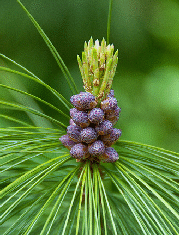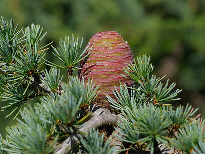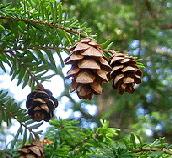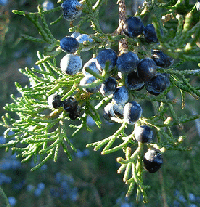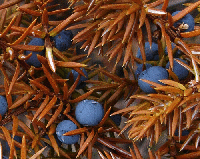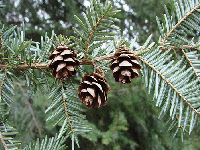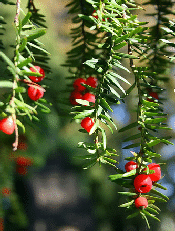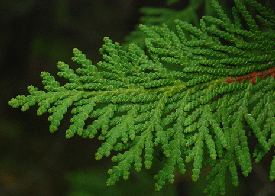Evergreen Conifer Families
The conifer division of plants have evergreen needles rather than broadleaf evergreen foliage like the rhododendron, with the exception of larches, baldcypress and dawn redwoods, which all have deciduous needles that completely shed each year. As always, there is confusion among botanists as to what characteristics should be common to the conifers. Conifers all bear seed cones, and the exception there is the yews, which produce berries. But gardeners are generally interested in the common reference of conifers as evergreens, and we all know what those are. The most commonly grown evergreens includes pines, cedars, spruce, junipers, fir, hemlock, yew, arborvitae, and a few other relatives.
The needles of the pine family clearly identify evergreen species as pine. The needles are produced groups of two, three, or five needles, and are sheathed at the base of the bundle. The pines require full sunlight and are generally fast growing. The pine family includes the commonly grown large species Austrian Pine Pinus nigra, Japanese Black Pine Pinus thunbergiana, Scotch Pine Pinus sylvestris, and White Pine Pinus strobus. Mugo Pine Pinus mugo, a small to medium evergreen shrub, is also a member of the family. There are 114 species in the Pinus genus, many of them native in parts of North America. They tend to adapt well to poor soils and some are quite drought tolerant.
Cedars produce needles in bunches, with cones that are upright on the top of the branches. Cedrus is are true Cedar, and most don’t care for the cold temperatures of the North and much of the Midwest. However False Cypress, chamaecyparis spp., is part of this group, many of which are very hardy. Both tree and shrub forms are available. The great variety of size, form, color and texture have made the false cypress very popular
Spruce produce their needles singly, attached to the branch with a little peg base. They are stiff, sharp and only an inch or less long. Spruce shed their needles periodically leaving the peg behind, which gives the branches a very course texture. The needles are not flat as they are with most conifers. The seed cones dangle from the branches when the tree is mature and remain attached for several months. Spruce love the cool climate of the North and Midwest. When grown in full sun they maintain a dense and symmetrical shape, many reaching 125 to 150 feet tall. Growing two to three feet a year once established, they can reach 15 feet in ten years. Many varieties of spruce are commonly grown in cool climates including the Blue Spruce, Colorado Spruce, Black Hills Spruce and Norway Spruce. The Dwarf Alberta Spruce is a miniature conical evergreen often grown in containers.
The genus Juniperus are actually a member of the cypress family. The genus is large and consists of so many commonly used landscape evergreens that it is generally referred to as simply the Junipers. Junipers range in size and shape from low growing groundcover shrubs to 40 foot trees. The foliage can be needles that are hard and sharp, or scale like similar to arborvitae, with females producing berries rather than c o n e s. I n s o m e varieties the needles will turn brown in autumn but do not drop. The berries are sometimes used as a spice, the only spice produced by conifers. They are best known for their use in flavoring gin. Junipers are very adaptable and tolerate poor dry soil better than most evergreens, and will also tolerate frequent shearing. They generally require full sun and none of the varieties will grow in wet soil or heavy shade. Not only do Junipers grow in a wide range of size and shape, foliage varies from yellow to green to blue green to gray green or silver. The stems are aromatic when pruned and contact with both the stems and foliage may cause itching.
Fir have flat needles are attached in pairs by a cup shaped base, and cones that are held upright. The needles are soft rather than stiff. Fraser Fir and Balsam Fir are most commonly known, forming symmetrical pyramids excellent for Christmas trees. They enjoy cool temperatures and cool, moist soil. Douglas Fir is not a true fir, belonging to a different genus.
Hemlock needles are flat and grow singly, generally growing opposite each other on the branch, creating a flat appearance. The genera is Tsuga, commonly included in the garden store name. Widely known common varieties are Canadian Hemlock and Hemlock Spruce. Hemlock are fussy and can be difficult to grow. They like a protected spot and should not be exposed to winter sun if possible. Cones tend to be smaller than most conifers, the Western Hemlock in particular has cones less than an inch.
Yew needles are flat and very deep green. Rather than cones, red fruit is produced on female plants. In general yews are hardy and adaptable, making them a very popular conifer. They grow well in shade which is unusual for conifers. Some damage may occur in direct sun and strong winds, and winter may dessicate foliage in the north. But damage is easily pruned or sheared out, and the yew quickly recovers. An excellent evergreen for shaded areas in cold climates. Yews are available in spreading form, upright and rounded.
Arborvitae foliage forms in flat branchlets with scale like mature foliage, needle like when young. Arborvitae evergreens are shrubs or small trees, however some will reach 40 to 60 feet tall. Many of the varieties are quite hardy, but some may be susceptible to injury by late frosts or winter dessication. Eastern arborvitae are widely used since they are easily propagated, resulting in affordable pricing. Eastern arborvitae is also known as American arborvitae or white cedar. Small cones are produced. In some varieties they look more like tiny pale green buds than cones.
Significant confusion has been created by the confusing naming of plants. For example: Cypress, the family Cupressaceae, is used to name plants in the genera Cupressus and Chamaecyparis, as well as other genera in the family. The family Cupressaceae has seven subfamilies. One of those subfamilies is Cupressoideae. Included in the subfamily Cupressoideae are Thuja Arborvitae, Chamaecyparis Cypress, Callitropsis Cypress, Cupressus Cypress and Juniperus Juniper. Since 1. the naming of plants is so confusing and 2. since even botanist have difficulty agreeing on distinguishing characteristics and 3. some families and genus are so large and similar, conifers in the Midwest Gardening pages will be addressed as individual species and named cultivars, addressing the specific needs and characteristics of the specific plant. Care will be taken to name the plants as completely as possible, as well as reference known common names.
